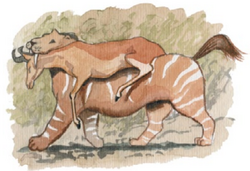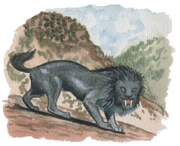| ||||||||||||||
Tigres de montagne (French: "mountain tiger") are a group of cryptid cats reported from mountainous regions of northern Central Africa, mainly in Chad, the Central African Republic, and South Sudan.[4][2] They are distinguished by their large size, red coats, and prominent fangs. Cryptozoologists speculate that they may be surviving sabre-toothed cats (subfamily Machairodontinae),[1] with which they have sometimes been identified by witnesses. The local names of many of the best-known tigres de montagne are unattested, leading to the generic term tigre de montagne becoming a specific name for some of these cryptids.
A second category of long-fanged cryptids, called water lions, have also been reported from the Central African Republic and Chad. These aquatic cryptids have sometimes been synonymised with the tigre de montagne, but, with their distinct habitats,[4] the two groups would be different species, with unique behaviours and ecologies.[2]
Attestations[]
While cryptids retrospectively classified as tigres de montagne have been known since the 1950s, the prototypical tigre de montagne, the animal inhabiting the mountains of Chad's Ennedi Plateau, was reported by Christian Le Noël during the 1960s. It is known to the local Zaghawa people (whose name for the animal is unrecorded) and French settlers, who term it the tigre de montagne. The coq-djingé is reported from Ouanda-Djallé in the Central African Republic, where it is also called tigre de montagne by French locals. A number of other tigres de montagne are also reported from Ouanda-Djallé.[5]
List of tigres de montagne[]
- Coq-djingé (Yulu: "red cat" or "dangerous cat"): Massif des Bongos, Central African Republic
- Gassingrâm: Central African Republic
- Hadjel (Hadjeray): Guera Massif, Chad
- Nisi (Tedda): Tibesti Mountains, Chad
- Tigre de montagne (Zaghawa): Ennedi Plateau, Chad
- Vassoko: Central African Republic
- Yassou: Ouaddaï Highlands, Chad
- "Imatong tiger": Imatong Mountains, South Sudan
- "Cave lion": Mali
Disputed[]
Description[]

Depiction of a tigre de montagne carrying prey by Philippe Coudray in Guide des Animaux Cachés (2009).
The tigre de montagne is said to be larger than a lion (perhaps up to a metre and a half at the withers, or the size of a horse or a donkey) and has red or reddish-brown fur, usually with vertical white stripes. The Yulu people also describe a melanistic variety. It has long, protruding teeth which extend past its lips (which are not described in the gassingrâm), very long hair on its legs and paws, and is either tailless or has a very short, bushy, hyena-like tail.[1][6] The gassingrâm[7] and vassoko are additionally said to have eyes that glow like lamps or even a lighthouse during the night; the vassoko is said to have small, dog-like ears;[2] and the hadjel is described as being maned.[1]
It lives in caves in relatively dry, mountainous regions, and is widely considered to be nocturnal. A predatory animal, it is apparently extremely strong, and is capable of effortlessly picking up and carrying off prey as large as an antelope, sometimes hoisting the prey onto its own back:[3] Bernard Heuvelmans also theorises that they are capable of killing adult elephants, something lions rarely do.[2][note 1] It also has a terrific roar, sometimes likened to the bellowing of an elephant.[1][6] The hadjel is said to mainly take small prey because the great size of its teeth makes it painful for it to open its mouth, and is considered by the Hadjeray people to be less dangerous than a lion because of this.[1] Similarly, the nisi is reputed to kill but not eat animals such as goats and chickens, suggesting to Heuvelmans that it may lap up their blood. According to some informants, the vassoko is followed around by clouds of butterflies.[2]
The long hair on the vassoko's legs and paws, or the hair of its bushy tail, supposedly eradicates any tracks it leaves,[1][6] but the tracks of the South Sudanese Imatong tiger were once found. These prints are allegedly as long as those of a boy, but clawed, and show that the animal is plantigrade.[3] The gassingrâm was also said to leave tracks larger than those of a lion.[8]
Tigres de montagne are said to inhabit:[1][2]
- Central African Republic: Birao, the Massif des Bongos or Bongo Massif, and Ouanda Djallé
- Chad: the Ennedi Plateau, the Tibesti Mountains, the Guera Massif, "and other mountainous areas"
- South Sudan: Imatong Mountains
Signifcant sightings[]
~1950s[]
Sometime before 1959, some workers toiling in the Acholi Hills, the western ranges of the Imatong Mountains in what is now South Sudan and Uganda, reported to J. K. Jackson that they had seen a creature unknown to them:[9]
| “ | Some labourers working high in the Acholi hills clearing firelines came to me with a tale of having seen a large animal, bigger than a lion and very broad. Its head was large, with a pointed muzzle, and a black mouth with long canine teeth. The general colour was brownish, with vertical yellowish-white stripes on its flanks. It left an elongated footprint, the size and shape of that of a small boy, but with claws. The beast was quite unknown to them, and they were very scared about it.
|
” |
Jackson, who identified the animal as a Nandi bear, passed on the description to the Deputy Inspector of Hunts at Torit, a Major Anderson, who told Jackson that, like most "Nandi bears," it was probably an abberant spotted hyena (Crocuta crocuta). Jackson, who did not believe that a large unknown carnivore could exist there, agreed.[2]
~1940[]
In 1970, when Christian Le Noël showed his trackers images of various living and extinct cats, the trackers unhesitatingly selected the image of Smilodon as the tigre de montagne, then recounted to him a notable sighting which had occured around thirty years earlier.[6]
| “ | To convince me, they took me to a rock shelter cave where, according to them, there was a "mountain tiger" about thirty years ago (we were in 1970). My first tracker Djémé affirmed to have seen it with his father during a hunting party in these hills of Méllé. He and his father had managed to kill a horse antelope (300 kg) and at the time of the skinning, a "mountain tiger" had emerged from the bush to seize the trophy and had won without apparent effort, in front of both Terrified and dumbfounded hunters who had not asked for their rest and had returned empty-handed to the village.
|
” |
1969[]
While approaching a large cavern in Ouanda Djallé alongside an elderly game tracker, Christian Le Noël heard a "terrible roar" which he could not identify coming from within the cavern. His tracker identified the call as that of a tigre de montagne, and refused to go any closer to the cavern.[10]
Theories[]

Depiction of a maned and melanistic tigre de montagne by Philippe Coudray in Guide des Animaux Cachés (2009).

Reconstruction of the African sabre-toothed cat Megantereon with its antelope prey, by Mauricio Antón.
When Christian Le Noël showed his Yulu trackers colour drawings of felines including tigers, ocelots, cheetahs, snow leopards, cougars, and a sabre-toothed cat, the trackers immediately pointed to the sabre-toothed cat as "their" mountain tiger. Le Noël argues that the trackers "cannot confuse two types of big cats, even if they have similar characteristics," and points out that there would be no reason for a purely mythical animal to be described as being occasionally melanistic.[6] All true sabre-toothed cats belonged to the subfamily Machairodontinae (~20 MYA–9 KYA), one of the three main felid subfamilies, alongside Pantherinae (the big cats) and Felinae (the small cats). Machairodonts were common in Africa, and the remains of the several genera have been discovered in Chad, which had a great diversity of Cenozoic felids, most prominently the very large Miocene species Amphimachairodus kabir (~9–5 MYA). Shorter-canined machairodonts, sometimes called dirk-toothed cats, were also common in Africa. Dinofelis (~7–1 MYA) was one of the most abundant African felids of its time, and has been found in North, East, and South Africa, including Chad. The widespread scimitar-toothed cat Homotherium (~4–0.7 MYA) is also a common component of Plio-Pleistocene African assemblages.[11]
Two tigres de montagne, the yassou of Chad and the animal reported from the Imatong Mountains, were described as plantigrade (i.e. flat-footed), and the yassou was also compared to a bear. Of all the known Plio-Pleistocene machairodonts, this description could only apply to Homotherium.[10] While Homotherium was the last known machairodont to exist in the Old World, and one of the most common machairodonts in Quaternary Africa, the youngest known African fossils are Plio-Pleistocene in age, with the most recent dating to around 700,000 years ago.[11] If all the tigres de montagne are indeed synonymous, the descriptions of the yassou and the Imatong Mountains animal imply a Homotherium identity for them.[10]
Bernard Heuvelmans suggests that a species of sabre-toothed cat could have adapted to a nocturnal life in the mountains in order to avoid competition with lions. According to this theory, the tigre de montagne carries its larger prey, such as antelopes and warthogs, into the mountains in order to escape from scavengers, as its large teeth would make it a slow eater (a supposition confirmed by descriptions of the hadjel); and its sabre teeth would be used to dig up animals such as rodents, hares, porcupines, lizards, snakes, and large insects. These smaller animals would make up the bulk of its diet, and it would often lap up the blood of its prey instead of eating their flesh, due to the size of its teeth.[2][3] Such a lifestyle would make it a sort of evolutionary counterpart to water lions, which Heuvelmans theorised are sabre-toothed cats which became adapted to an aquatic habitat in order to avoid competition with other predators, and which could use their fangs to dig up shellfish. Just as the water lion would fill the niche of an animal like the jaguar, the tigre de montagne, Heuvelmans suggests, would fill the ecological niche left empty by the absence of bears in Africa.[2]
Further cryptozoological reading[]
- Heuvelmans, Bernard & Rivera, Jean-Luc & Barloy, Jean-Jacques (2007) Les Félins Encore Inconnus d’Afrique, Les Editions de l'Oeil du Sphinx, ISBN 978-2914405430
Notes and references[]
- ↑ The Central African Republic has been the source of uncommon reports of "lions" killing adult elephants, even in regions where lions are not known to live. In one incident, the perpetrator was named as a mourou-ngou, but given that the region was hilly and dry, Heuvelmans feels that a tigre de montagne is the more likely culprit.
- ↑ 1.0 1.1 1.2 1.3 1.4 1.5 1.6 1.7 1.8 1.9 Eberhart, George M. (2002) Mysterious Creatures: A Guide to Cryptozoology, ABC-CLIO, Inc., ISBN 1576072835
- ↑ 2.00 2.01 2.02 2.03 2.04 2.05 2.06 2.07 2.08 2.09 2.10 2.11 2.12 2.13 2.14 Heuvelmans, Bernard & Rivera, Jean-Luc & Barloy, Jean-Jacques (2007) Les Félins Encore Inconnus d’Afrique, Les Editions de l'Oeil du Sphinx, ISBN 978-2914405430
- ↑ 3.0 3.1 3.2 3.3 Coudray, Philippe (2009) Guide des Animaux Cachés, Editions du Mont, ISBN 978-2915652383
- ↑ 4.0 4.1 Heuvelmans, Bernard "Annotated Checklist of Apparently Unknown Animals With Which Cryptozoology Is Concerned", Cryptozoology, No. 5 (1986)
- ↑ Shuker, Karl P. N. (2016) Still In Search Of Prehistoric Survivors: The Creatures That Time Forgot?, Coachwhip Publications, ISBN 978-1616463908
- ↑ 6.0 6.1 6.2 6.3 6.4 Le Noël, Christian Institut Virtuel de Cryptozoologie LE TIGRE DES MONTAGNES : DES FELINS A DENTS EN SABRE AU COEUR DE L'AFRIQUE? cryptozoo.pagesperso-orange.fr [Accessed 2014]
- ↑ Heuvelmans, Bernard (1978) Les Derniers Dragons d'Afrique, Plon, ISBN 978-2259003872
- ↑ Heuvelmans, Bernard (1955) On the Track of Unknown Animals, Routledge, ISBN 978-1138977525
- ↑ Jackson, J. K., "Animal Life in the Imatong Mountains" Sudan Wild Life and Sport, Vol. 1, No. 4 (December 1959)
- ↑ 10.0 10.1 10.2 Shuker, Karl P. N. (2020) Mystery Cats of the World Revisited: Blue Tigers, King Cheetahs, Black Cougars, Spotted Lions, and More, Anomalist Books, ISBN 978-1949501179
- ↑ 11.0 11.1 Werdelin, Lars & Sanders, William Joseph (2010) Cenozoic Mammals of Africa

